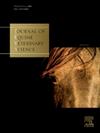Identifying insulinemic responses of ID horses offered varying levels of NSC and meal-sizes
IF 1.6
3区 农林科学
Q2 VETERINARY SCIENCES
引用次数: 0
Abstract
Background
Feeding small meals (∼1 g/kg BW DM basis) providing >10% nonstructural carbohydrates (NSC; starch + water soluble carbohydrate; WSC) has resulted in an augmented insulin response (AIR) in insulin dysregulated (ID) horses, but it’s unclear if AIR reflects NSC content or the g NSC/kg BW/meal.
Objectives and methods
The insulinemic responses of ID (n = 7) and non-insulin dysregulated (NID; n = 8) horses fed four feeds (A = 6.8% NSC; B = 14.9% NSC; C = 35.5% NSC; D = 44.6% NSC) at three levels of NSC intake (0.06, 0.11-0.12 and 0.17-0.18 g/kg BW) were evaluated in a randomized Latin square design across two phases.
Results
ID horses had higher incremental area under the curve (IAUCi; ID: 3223.05±3229.5 vs. NID: 907.2 ± 976.4 IU/mL*minute), 60-minutes post-meal consumption (T60; ID: 43.4 ± 48.8 vs. NID: 12.6 ± 14.6 µIU/ mL) and delta (ID: 20.9 ± 41.7 vs. NID: 6.2 ± 11.4 µIU/mL) insulin for all treatment diets compared to NID horses (p < 0.0001). In Phase 1, ID horse T60 insulin for feedstuff A, was higher with 0.17 compared to 0.06 and 0.11 g NSC/kg BW/meal (p = 0.02); and for B, again, greater for the 0.11 and 0.17 than the 0.06 g NSC/kg BW/meal (p = 0.002). In Phase 2, the T60 insulin of ID horses was higher when given D at 0.18 compared to 0.06 and 0.12 g NSC/kg BW/meal (p = 0.008).
Conclusion
Augmented post-prandial insulinemic responses occurred in ID horses fed small meals of pelleted feedstuffs with ≥0.11-0.12 g NSC/kg BW regardless of feed % NSC; however, considerable variation suggests the need for individual monitoring.
确定ID马提供不同水平的NSC和膳食量的胰岛素反应。
背景:小餐喂养(~ 1 g/kg BW DM),提供10 ~ 10%的非结构性碳水化合物(NSC;淀粉 + 水溶性碳水化合物;WSC导致胰岛素失调(ID)马的胰岛素反应(AIR)增强,但AIR是否反映NSC含量或g NSC/kg BW/meal尚不清楚。目的与方法:糖尿病患者(n=7)和非胰岛素失调患者(NID;n=8)饲喂4种饲料(A=6.8%NSC;nsc B = 14.9%;nsc C = 35.5%;D=44.6% NSC)在3个NSC摄食水平(0.06、0.11-0.12和0.17-0.18 g/kg BW)下,采用随机拉丁方设计,分两个阶段进行评估。结果:ID马曲线下增量面积(IAUCi)较高;ID: 3223.05±3229.5 vs. NID: 907.2±976.4 IU/mL*min),餐后60分钟消耗(T60;与NID马相比,所有处理日粮的胰岛素ID: 43.4±48.8 vs. NID: 12.6±14.6µIU/mL)和δ胰岛素(ID: 20.9±41.7 vs. NID: 6.2±11.4µIU/mL) (p结论:无论饲料中NSC的百分比如何,喂食少量含≥0.11-0.12 g NSC/kg BW的颗粒饲料的ID马餐后胰岛素反应增强;然而,相当大的差异表明需要进行个人监测。
本文章由计算机程序翻译,如有差异,请以英文原文为准。
求助全文
约1分钟内获得全文
求助全文
来源期刊

Journal of Equine Veterinary Science
农林科学-兽医学
CiteScore
2.70
自引率
7.70%
发文量
249
审稿时长
77 days
期刊介绍:
Journal of Equine Veterinary Science (JEVS) is an international publication designed for the practicing equine veterinarian, equine researcher, and other equine health care specialist. Published monthly, each issue of JEVS includes original research, reviews, case reports, short communications, and clinical techniques from leaders in the equine veterinary field, covering such topics as laminitis, reproduction, infectious disease, parasitology, behavior, podology, internal medicine, surgery and nutrition.
 求助内容:
求助内容: 应助结果提醒方式:
应助结果提醒方式:


